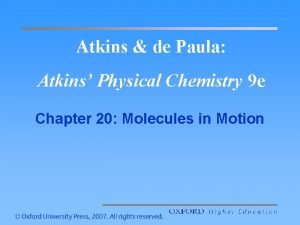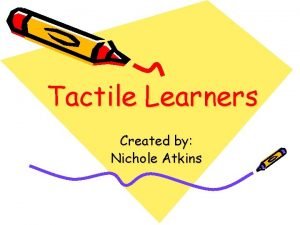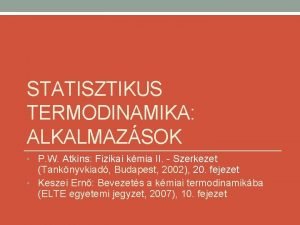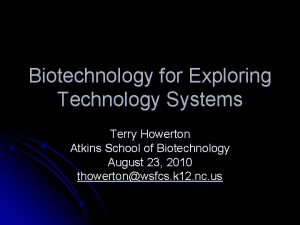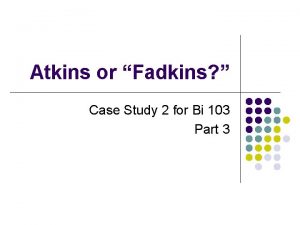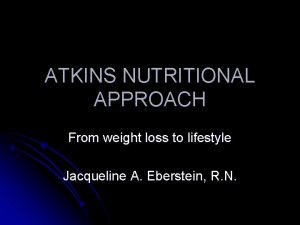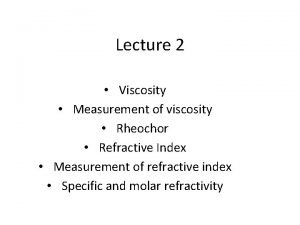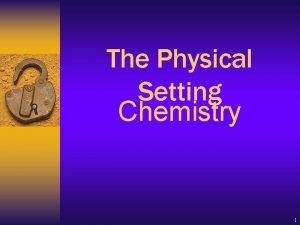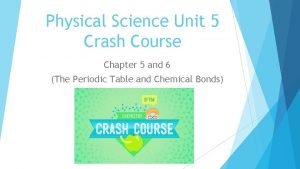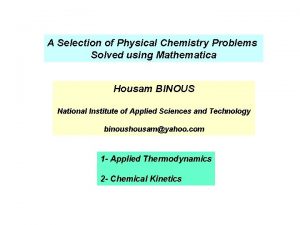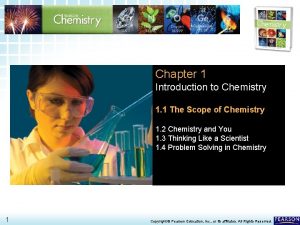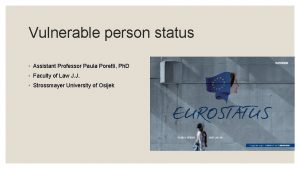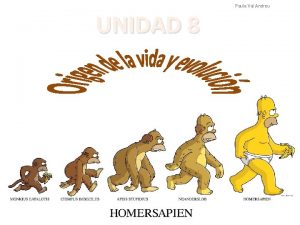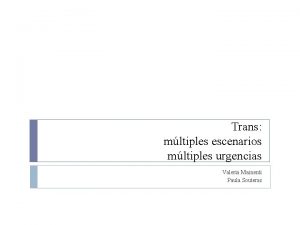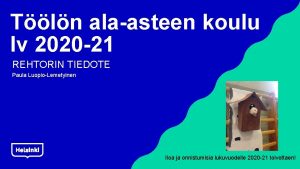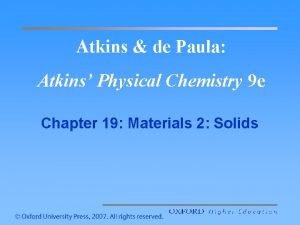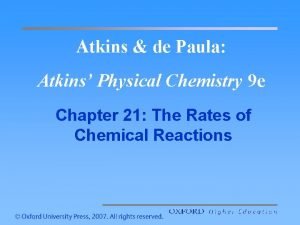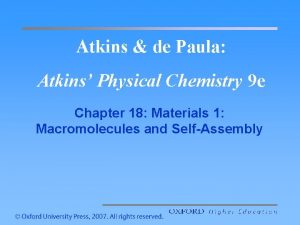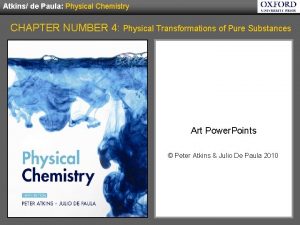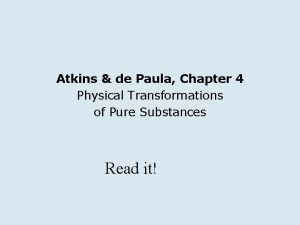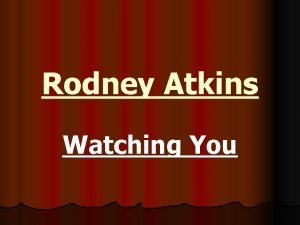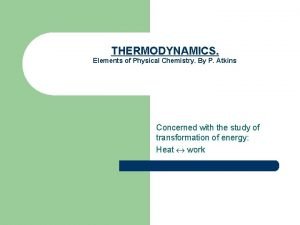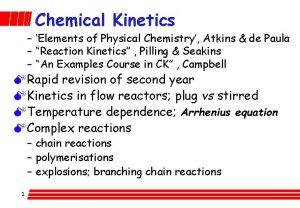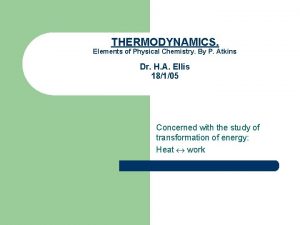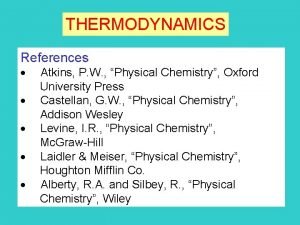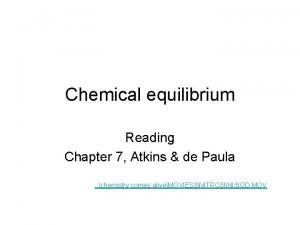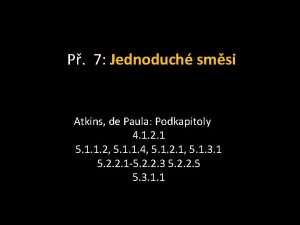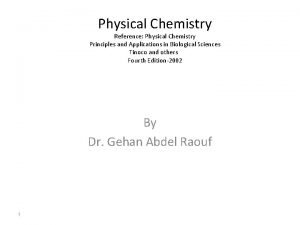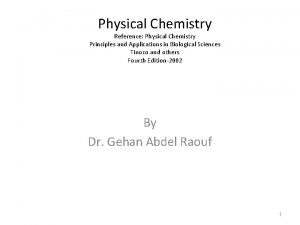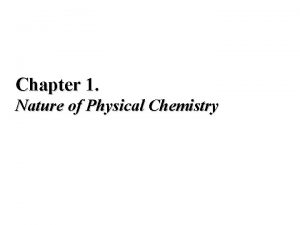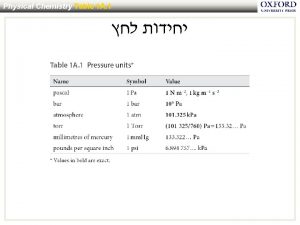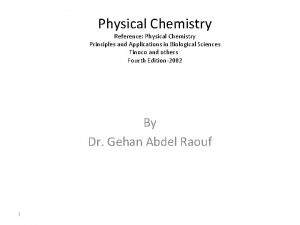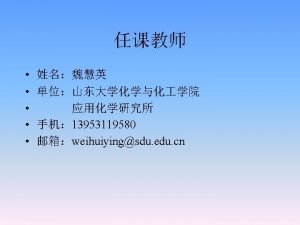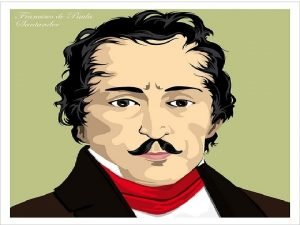Atkins de Paula Atkins Physical Chemistry 9 e






























- Slides: 30

Atkins & de Paula: Atkins’ Physical Chemistry 9 e Chapter 22: Reaction Dynamics

Chapter 22: Reaction Dynamics REACTIVE ENCOUNTERS 22. 1 Collision theory rate constant, kr encounter rate minimum energy requirement steric requirement. 22. 1(a) Collision rates in gases collision density, the number of (A, B) collisions in a region of the sample in an interval of time divided by the volume of the region and the duration of the interval:

Chapter 22: Reaction Dynamics collision cross-section 22. 1(b) The energy requirement

Chapter 22: Reaction Dynamics

Chapter 22: Reaction Dynamics

Chapter 22: Reaction Dynamics 22. 1(c) The steric requirement steric factor, P = σ*/σ. reactive cross-section, σ*, the area within which a molecule must approach another molecule for reaction to occur. rate constant from collision theory, harpoon mechanism, a process in which electron transfer precedes atom extraction. (Exercise Example 22. 2!)

Chapter 22: Reaction Dynamics 22. 1(d) The RRK model The Rice–Ramsperger–Kassel model (RRK model), a model that takes into account the distribution of energy over all the bonds in a molecule. Lindemann-Hinshelwood mechanism Exp. data for unimolecular isomerization of trans-CHD=CHD RRK model s

Chapter 22: Reaction Dynamics 22. 2 Diffusion-controlled reactions cage effect, the lingering of one molecule near another on account of the hindering presence of solvent molecules.

Chapter 22: Reaction Dynamics 22. 2(a) Classes of reaction diffusion-controlled limit, a reaction in which the rate is controlled by the rate at which reactant molecules encounter each other in solution. activation-controlled limit, a reaction in solution in which the rate is controlled by the rate of accumulating sufficient energy to react.

Chapter 22: Reaction Dynamics 22. 2(b) Diffusion and reaction

Chapter 22: Reaction Dynamics 22. 3 The material balance equation

Chapter 22: Reaction Dynamics TRANSITION STATE THEORY transition state theory (or activated complex theory, ACT), a theory of rate constants for elementary bimolecular reactions. transition state, the arrangement of atoms in an activated complex that must be achieved in order for the products to form. 22. 4 The Eyring equation Our task!!

Chapter 22: Reaction Dynamics 22. 4(a) The rate of decay of the activated complex transmission coefficient, κ, the constant of proportionality between the rate of passage of the complex (k‡) through the transition state and the vibrational frequency along the reaction coordinate ( ‡); k‡ = κ ‡. 22. 4(b) The concentration of the activated complex

Chapter 22: Reaction Dynamics 22. 4(c) The rate constant 22. 4(d) The collision of structureless particles

Chapter 22: Reaction Dynamics 22. 4(e) Observation and manipulation of the activated complex Na+I- decay Photoreaction of IH∙∙∙OCO van der Waals complex IH∙∙∙OCO HOCO resembles the activated complex of H + CO 2 [HOCO] ‡ HO+CO

Chapter 22: Reaction Dynamics 22. 5 Thermodynamic aspects 22. 5(a) Activation parameters correlation analysis, a procedure in which ln K (=-Δr. Gθ/RT) is plotted against ln k (proportional to -Δ‡G /RT). liner free energy relation (LFER), a linear relation obtained in correlation analysis; reaction becomes thermodynamically more favorable.

Chapter 22: Reaction Dynamics 22. 5(b) Reactions between ions kinetic salt effect, the effect of a change in ionic strength on the rate constant of a reaction. Exercise Example 22. 3!

Chapter 22: Reaction Dynamics THE DYNAMICS OF MOLECULAR COLLISIONS 22. 6 Reactive collisions 22. 6(a) Experimental probes of reactive collisions infrared chemiluminescence, a process in which vibrationally excited molecules emit infrared radiation as they return to their ground states. IR chemiluminescence O+CS CO+S

Chapter 22: Reaction Dynamics laser-induced fluorescence (LIF), a technique in which a laser is used to excite a product molecule from a specific vibration–rotation level and then the intensity of fluorescence is monitored.

Chapter 22: Reaction Dynamics multiphoton ionization (MPI), a process in which the absorption of several photons by a molecule results in ionization. resonant multiphoton ionization (REMPI), a technique in which one or more photons promote a molecule to an electronically excited state and then additional photons are used to generate ions from the excited state. A laser pulse excites electrons in a semiconductor surface (10 layers C 60 on a Cu(111) substrate) which in turn pass their energy to adsorbed molecules (NO). REMPI measures the motion of the desorbed molecules.

Chapter 22: Reaction Dynamics reaction product imaging, a technique for the determination of the angular distribution of products. Reaction products detected in the Streamer Chamber when a 1. 1 -Ge. V-per-nucleon beam of holmium-165 collided with a holmium-165 target at the Bevalac.

Chapter 22: Reaction Dynamics 22. 7 Potential energy surfaces potential energy surface, the potential energy as a function of the relative positions of all the atoms taking part in the reaction. HA + HB-HC HA-HB + HC

Chapter 22: Reaction Dynamics saddle point, the highest point on a potential energy surface encountered along the reaction coordinate. HA + HB-HC HA-HB + HC

Chapter 22: Reaction Dynamics saddle point, the highest point on a potential energy surface encountered along the reaction coordinate. HA + HB-HC HA-HB + HC

Chapter 22: Reaction Dynamics Example of potential energy surfaces. Ultrafast reaction dynamics of the complete photo cycle of an indolylfulgimide studied by absorption, fluorescence and vibrational spectroscopy

Chapter 22: Reaction Dynamics 22. 8 Some results from experiments and calculations HA + HB-HC HA-HB + HC

Chapter 22: Reaction Dynamics HA + HB-HC HA-HB + HC

Chapter 22: Reaction Dynamics 22. 8(a) The direction of attack and separation 300

Chapter 22: Reaction Dynamics 22. 8(b) Attractive and repulsive surfaces attractive surface, a potential energy surface in which the saddle point occurs early on the reaction coordinate. repulsive surface, a potential energy surface in which the saddle point occurs late on the reaction coordinate. H + Cl 2 HCl +Cl attractive surface repulsive surface

Chapter 22: Reaction Dynamics 22. 8(c) Classical trajectories direct mode process, a bimolecular process in which the switch of partners takes place very rapidly. complex mode process, a bimolecular process in which the activated complex survives for an extended period. direct mode process complex mode process
 Dz atkins
Dz atkins South beach phase 1 food list
South beach phase 1 food list Brenda judd and sandra colley
Brenda judd and sandra colley Heather nichole atkins
Heather nichole atkins Atkins fizikai kémia
Atkins fizikai kémia Uncc library login
Uncc library login Atkins and murphy reflective model
Atkins and murphy reflective model Terry howerton
Terry howerton Atkins or fadkins case study answers
Atkins or fadkins case study answers Atkins lifestyle
Atkins lifestyle Ib organic chemistry
Ib organic chemistry Inorganic chemistry vs organic chemistry
Inorganic chemistry vs organic chemistry Explain rheochor
Explain rheochor Subatomic particles can usually pass undeflected
Subatomic particles can usually pass undeflected Physical chemistry crash course
Physical chemistry crash course Determination of transport number by hittorf method
Determination of transport number by hittorf method Physical chemistry problems
Physical chemistry problems Scope of physical chemistry
Scope of physical chemistry Chemical change examples pictures
Chemical change examples pictures Rate fences services marketing
Rate fences services marketing Physical activity and physical fitness assessments grade 9
Physical activity and physical fitness assessments grade 9 Paula poretti
Paula poretti Dr aaron gilliam
Dr aaron gilliam Paula val
Paula val Paula figari
Paula figari Trans paula valeria bedoya
Trans paula valeria bedoya Paula luopio-lemetyinen
Paula luopio-lemetyinen Superman and paula brown’s new snowsuit
Superman and paula brown’s new snowsuit Superman and paula brown's new snowsuit summary
Superman and paula brown's new snowsuit summary Paula reponen rovaniemi
Paula reponen rovaniemi Jolanta babiak
Jolanta babiak
